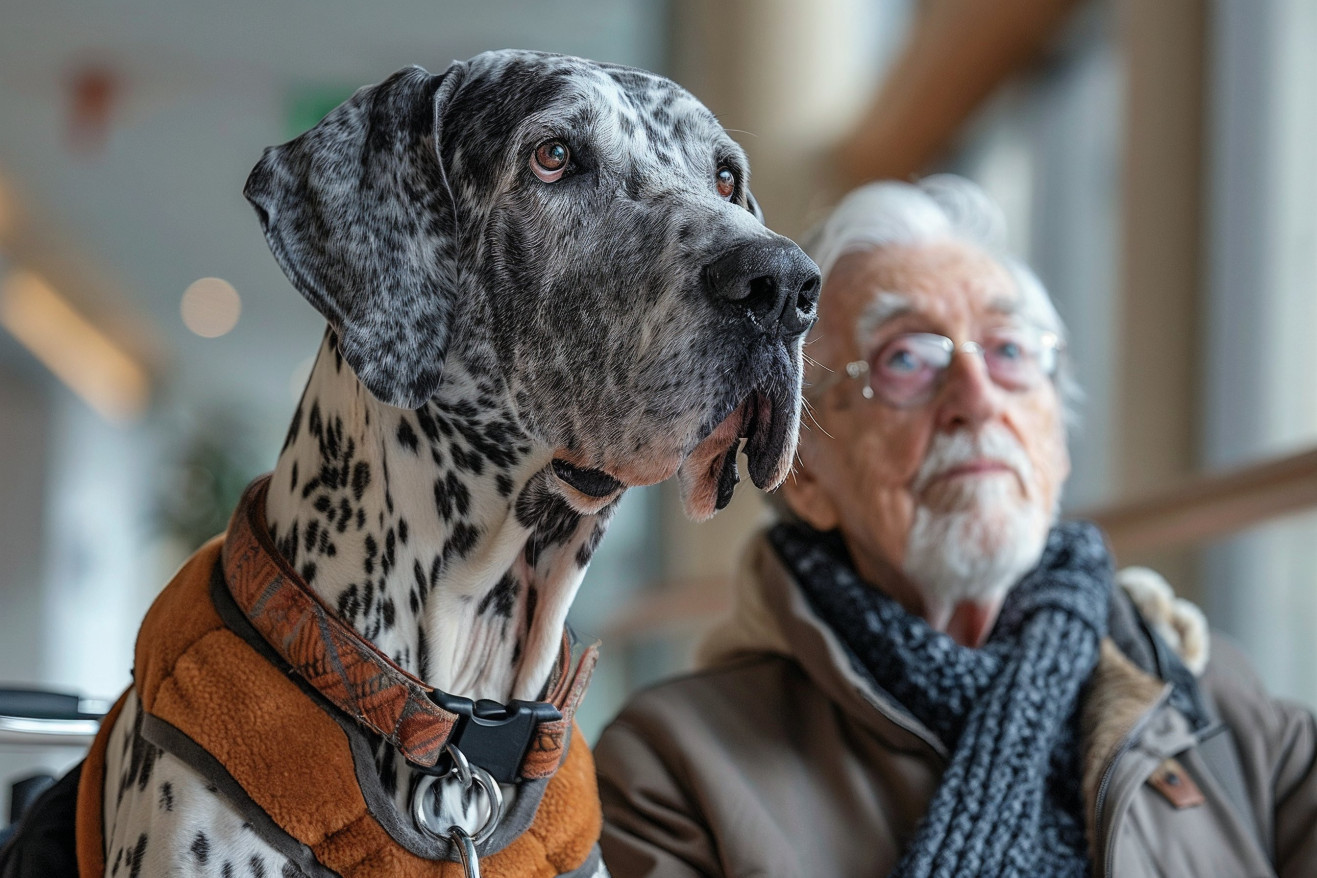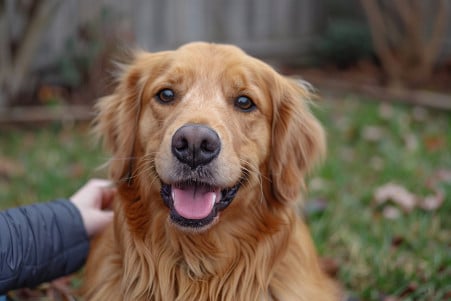Are Great Danes Good Service Dogs? Their Service Potential Explored
7 June 2024 • Updated 6 June 2024

Great Danes are known for their friendly and easygoing nature, but they may not be the first breed that comes to mind when you think of service dogs. However, these sweet-tempered dogs can be valuable service animals in certain capacities. Despite their large size, Great Danes are the perfect temperament and size to be trained as mobility service dogs, offering balance and brace support to people with disabilities. Their calm and loving nature also makes them good candidates for other service dog roles.
In this article, we'll look at studies conducted by professional dog trainers, breed experts, and disability service organizations to provide a well-rounded view of the unique qualities of Great Danes that enable them to assist people with disabilities. We'll also consider the logistical concerns that need to be taken into account, giving you a better idea of the potential roles and responsibilities of this regal breed.
Are Great Danes good service dogs?
What Makes Great Danes Good Service Dogs?
Great Danes are well-suited to a variety of service dog roles due to their large size and gentle nature. Their size and strength enable them to help with mobility tasks, such as providing balance and bracing support, that smaller dogs can't. As CertaPet points out, their height is especially helpful for people in wheelchairs or those with other mobility issues because it allows them to reach and support their handlers more effectively.
In addition to physical tasks, the breed's sweet and loving disposition makes them well-suited to psychiatric service dog work. Their calm, loving nature and ability to stay on task make them perfect for providing emotional support, companionship, and comfort to people with PTSD, anxiety, depression, and other mental health conditions. This breed's loving nature makes them a perfect fit for roles that require them to be a comforting presence.
Great Danes are also practical for service dog work because they require less exercise and shed less than many other breeds. This can help reduce the physical burden on their handlers. In addition, their trainability and desire to please means they can be trained to do a variety of tasks when their skills are honed by an expert trainer. This enables them to learn and perform the tasks they need to do to help their handlers.
Training and Socialization Needs
Great Danes need a lot of socialization and training as puppies to become successful service dogs. The Service Dog Training School explains that their size and strength mean that they need to be trained in a way that will help them learn to be in control and follow commands. Puppies need to be carefully evaluated to make sure they have the right personality and skills for service work.
In addition, US Service Animals says that Great Danes shouldn't be trained to do any physically demanding tasks until they are 1.5-2 years old and fully grown. It's also important to work with professional trainers who have experience training Great Danes to be service dogs. Wag! explains that this will help ensure that the dog is socialized, focused on its handler, and able to stay calm in any situation, all of which are important for a successful service dog.
How to Get a Great Dane Service Dog
Organizations such as the Service Dog Project specifically breed and train Great Danes to become service dogs. The process of getting a Great Dane service dog typically includes an application, assessment, and matching period. The dogs are also given pet insurance that is then transferred to the human partner after they graduate, according to Service Dog Project.
The cost of a fully trained Great Dane service dog can be anywhere from $17,000 to over $40,000, however, Integrity Inc. explains that many organizations can help with fundraising or grant applications for those who qualify. Taking care of a Great Dane service dog means making sure to meet their specific needs, including exercise, grooming, and veterinary care. According to The Salem News, this also means that handlers need to make sure they can provide an appropriate home and commit to the dog's care and training for the long term.
Pros and Cons of Great Danes as Service Dogs
Great Danes' size and strength enable them to help with tasks that smaller dogs can't, like providing physical support and balance to people with mobility issues. The American Kennel Club says their size is especially helpful for people in wheelchairs or people with limited mobility because it helps them get around in everyday situations. In addition, their sweet and gentle temperament makes them great for service work that involves emotional support or working with kids.
On the other hand, Great Dane Care says that Great Danes are more expensive to care for, have shorter life spans, and can be difficult to manage because of their size. They aren't as easy to take with you as smaller service dog breeds and need more room to live. It's also important to make sure they are trained and socialized properly so that their size and strength don't become a problem. Although their size and strength enable them to do things other dogs can't, these practical concerns need to be taken into account when deciding if a Great Dane is the right service dog for you.
Service Dog Access and Etiquette for Great Danes
The Americans with Disabilities Act (ADA) states that service dogs are allowed in all public areas, regardless of their breed and size. Disability Rights Ohio notes that businesses are allowed to ask two questions: whether the dog is a service animal and what tasks the dog has been trained to perform, but they cannot request any documentation.
If you come across a Great Dane service dog in public, it's important to remember not to distract the dog or interact with it without the handler's permission. As Atlas Assistance Dogs points out, you should direct your attention to the handler, not the dog, and never offer the dog food or treats, which can disrupt the dog's training and job. You should also make sure to give service dog teams plenty of space and the right-of-way and avoid asking the handler personal questions about their disability.
Conclusion: The Future of Great Danes as Service Dogs
Great Danes have a combination of physical and temperamental traits that make them well-suited to a variety of service dog roles. With the right training and socialization, these dogs can help people with mobility, balance, and psychiatric disabilities in ways that other breeds can't.
While their size and grooming needs can be challenging, reputable organizations are proving that Great Danes can be successful service dogs. As a result, it's likely that more and more people will come to recognize and rely on Great Danes for their service dog needs. However, it's important that people continue to research and learn about the breed to ensure that Great Danes are trained and used responsibly as service dogs.


